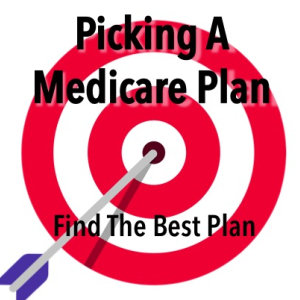Medicare is complcated but this can help you simplify finding the best plan for you
Picking A Medicare Plan In 5 Steps
 Medicare is complex. Picking a Medicare plan is a daunting task when you are first enrolling. And continual changes mean you should really be comparing plans each year.
Medicare is complex. Picking a Medicare plan is a daunting task when you are first enrolling. And continual changes mean you should really be comparing plans each year.
The decisions you make will determine your health care and what (if anything) you’ll pay.
Here are 5 steps to help when picking a Medicare plan
- Know your timing
- Consider all options
- Don’t overlook drug costs
- Project ahead
- Seek good resources
1. Why Timing Medicare Is Important
Most people will enroll in Medicare when they turn 65. But not all.
For most Americans, the seven months bracketing your 65th birthday is the best time to enroll. This includes the 3 months prior to your birthday month and the 3 months after. There are several reasons that make this the ideal time.
Reason one is that you;’ll generally have the greatest choice of available options. For those considering Medicare Supplement (also called Medigap) coverage, during this time you are guaranteed coverage even if you have existing health issues. Afterwards you may not qualify. or, at the very least, you’ll likely have to pay more. And finally, you can avoid potential late penalties.
Ask the Medicare insurance professional you are working with for a document that lists all the important Medicare dates to remember.
2. Do Consider All Your Medicare Options
Original Medicare comes in two parts. Part A and Part B. And, about xx million Americans only have Original Medicare (2020 statistic).
Some xx.x million Americans have a Medicare Advantage plan (Medicare Advantage statistics). That’s referred to as Medicare C. These typically are the plans you see heavily advertised on television. Some come with $0 monthly premiums. Others do cost. Some include additional benefits like dental and vision, even transportation to medical appointments. It all sounds great. And, it can be. But remember, there never is a free lunch so understand what’s offered and what you might be missing.
There is Medicare Supplement or Medigap insurance. Around 14 million Americans have a Medigap plan (Medigap plan statistics). These plans do exactly what they sound like. They supplement gaps in Part A and Part B. They also provide some benefits that people look for. Like being able to see any doctor or health provider that accepts Medicare. Also coverage outside of the United States.
And, finally there is Medicare Part D. This is Prescription Drug Plan coverage. Sometimes today, it’s included within a Medicare Advantage plan. Other times it is purchased separately. With the cost of drgs and the likelihood you’ll be taking them, this is increasingly important coverage to have.
3. Don’t Overlook Drug Costs
A Georgetown University study reports (no surprise here) that prescription drug expenditures are highest for people age 65 and older.
We don’t like sharing ‘average’ costs because you are not average. Some seniors will pay very little or not even take prescription drugs. Others will take many and some costly ones. Some will need to take very costly medications.
For that reason, it’s really important to not overlook your current prescription drug needs. And, while none of us can predict your future, thinking ahead is probably wise. You have a good idea of whether your health is generally stable or potentially worsening.
4. Project Ahead
Many articles discussing picking a Medicare plan focus just on the here and now. But with Medicare we think you want to think ahead.
For example, do you plan to travel outside of the U.S.? If yes, then having a plan that can cover care when you are away from home could be desirable.
Are you considering a second home in another state? Some Medicare Advantage plans will not cover you in that second area. That doesn’t mean you can’t switch down the road; but at least know what’s in store as your life changes.
5. Seek Good Medicare Resources
The Association’s website is full of helpful tips on finding good Medicare insurance resources. Below are a few links.
 We do suggest you speak with at least one local Medicare insurance agent. He or she should know more about local plan options than even the best call center operator.
We do suggest you speak with at least one local Medicare insurance agent. He or she should know more about local plan options than even the best call center operator.
Use the free directory on this website to find one.
Read How do I find A Good Medicare Agent with 10 great questions to ask.